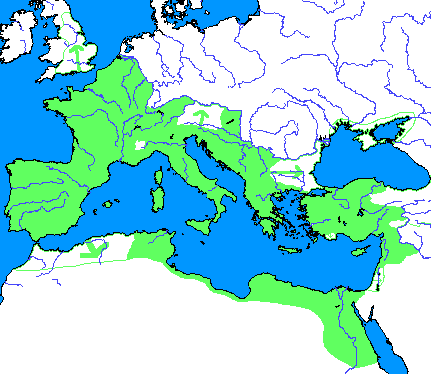User:Daanschr/ Historical maps/ Claudius
Claudius was appointed as emperor in 41 by the Praetorian Guard instead of the senate as appropriate. In his first year, there was a campaign against the Chauci to recover the last aquila, lost at the Battle of the Teutoberg Forest in 9. Commagene became a roman vassal state again under king Antiochus IV and Judea as well under king Agrippa I.
In 43, Claudius invaded Britain. South-eastern Britain was forced to pay tribute for a century since Julius Caesar invaded it (Caesar's invasions of Britain). In the 30s, the Catuvellauni made an end to this practise. So, Caligula planned an invasion, which was executed by Claudius. Aulus Plautius was the commander of the Roman forces. His main enemy in Britain were the Catuvellauni, commanded by Togodumnus and Caratacus. After the defeat of the Catuvellauni, the Romans expanded their territory to the north and the east. A couple of vassal states emerged, including the tribes of the Iceni and the Brigantes.
During the invasion of Britain, a couple of Roman vassal states were annexed. Lycia in 43. Judea in 44, after the death of king Agrippa I. The rebellion of the Berbers in Mauretania ended in 44, and Mauretania was annexed. In 46 followed Thrace, after the murder by his wife of king Rhoemetalces III of the Odrysian kingdom. Noricum was annexed during the reign of Claudius.
In 47, the commander of the Roman armies in Germania Inferior, Gnaeus Domitius Corbulo, had to deal with major uprisings and raids of the Germanic peoples. Corbulo erected several fortresses on the Rhine border, including probably fortress Matilo, which is hundred meters of my house. He advanced against the Frisians and the Chauci, but was recalled by emperor Claudius, because the Roman priority lay with the establishment of Roman power in Britain.
Governor Publius Ostorius Scapula had to deal with an uprising of the Iceni, who had voluntarily joined Roman Britain and didn't want to be disarmed. Afterwards, he expanded Roman territory with the conquest of the territories of the Cornovii and the Deceangli tribes. A coalition of Ordovices and Silures, commanded by the Caratacus of the Catuvellauni, was defeated at the Battle of Caer Caradoc in 50. The Silures continued to be a major enemy in the decades afterwards, continually raiding Roman territory.
Major turmoil broke out in Armenia when king Pharamanes I of Caucasian Iberia invaded the country, in order to replace his brother Mithridates with his son Rhadamistus. Claudius wanted to maintain peace, but the Roman procurator of Cappadocia, Julius Paelignus, invaded anyway. This evoked the Roman governor of Syria, Gaius Ummidius Durmius Quadratus to restore order in Armenia. King Vologases I of the Parthian Empire used the turmoil to claim Armenia as a Parthian vassal and installed his son Tiridates I as king in 52/53. The Parthians had to withdraw due to winter conditions, allowing Rhadamistus to return to the throne. His harsh punishment of Armenians who had been too friendly to the Parthians unleashed an Armenian revolt.
In 54, Claudius was probably murdered by poison.




